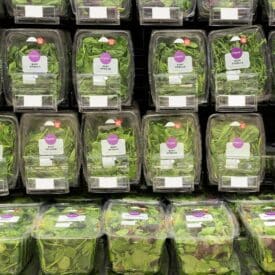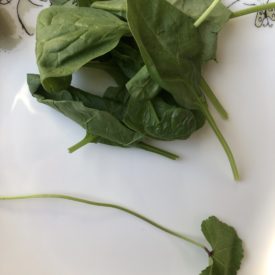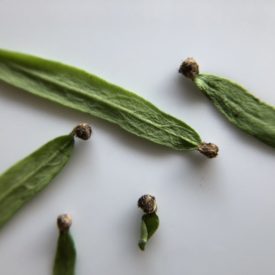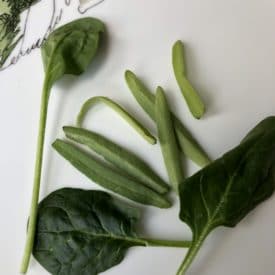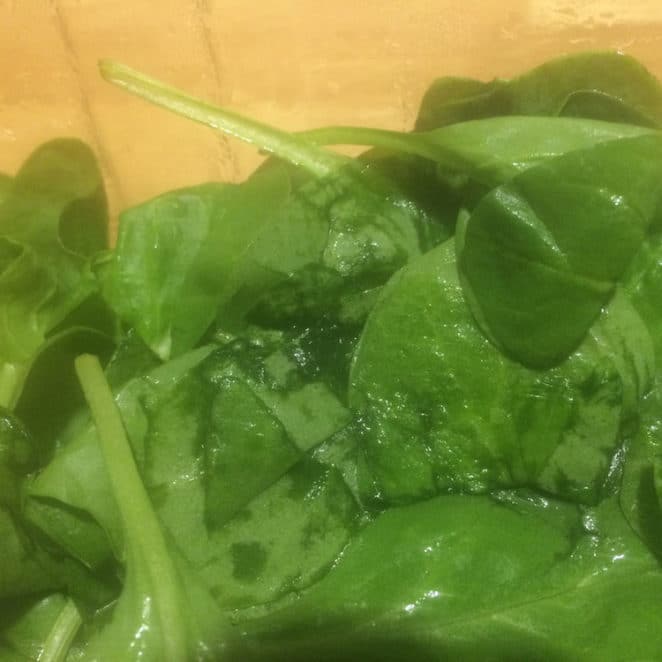
What you see: Spinach that looks “wet.”
What it is: Cell membranes breaking down, releasing water; generally, the leaves’ cells are collapsing. Bacteria may be present, though spoilage bacteria that won’t hurt you is most likely.
Eat or toss: Don’t eat the leaves raw, though they may be fine in a cooked dish.
Can you eat slimy spinach? What if it’s just a little soggy?
Spinach is more than 90 percent water, which explains why it’s pretty easy to sauté a 16-ounce clamshell of the fresh stuff into a teeny tiny pile of the steamed variety. That also helps explain why, when left forgotten in the fridge, spinach leaves shrivel into a puddle of “green slime.” It’s a consequence of the water escaping their cells as they age. It’s also a sign that bacteria could be enjoying the moisture and nutrient flood that pours out of the spinach as it ages.
The spinach pictured here is just starting its green slime journey. As the leaves age, their cell membranes break down, creating slow leaks through which water and other stuff seeps out. Thus we have these wet stains on some of the spinach leaves and the volume of each leaf decreases.
Ever noticed how some spinach leaves have a wet line or crease on them? Even if they looked pristine when you first buy them, those lines can appear with age. That’s likely evidence, explains Jim Monaghan, director of the Fresh Produce Research Centre at Harper Adams University, of the leaf having been folded over at some point, possibly when it was dropped into the clamshell or plastic bag you purchased it in. Even though the leaf bounced back from that folding and it took a long time to show evidence of it, the site of the bend gets the “wet look” first. The cell membranes along the line were weakened and thus were among the earliest to give out.
While these leaves could be perfectly fine, they are also more inviting to any lurking microbes, who, most likely are more focused on breaking down the spinach than causing you illness. If you feel anything especially slimy, that could be some bacteria’s calling card. And it’s not impossible for human-disease-causing bacteria to lurk on decomposing spinach and fortify itself, so we do suggest you proceed with some amount of care.
Once your spinach leaves start to develop this wet-ish look, it’s time to abandon any plans for salad and look to your favorite way to cook spinach. For me, it’s as easy as putting the spinach in the microwave with a splash of water and a dish on top to keep the moisture in. Several minutes later, we have steamed spinach and, while I’m not too worried about any problematic bacteria, I trust that the heat knocked out any troublemakers that might have been present. As a healthy adult, I’m fine with this approach, but if you’re serving an immunocompromised or other vulnerable person, you may want to be more careful and just compost the spinach.
In conclusion, don’t panic if you see some soggy spinach leaves, but considering giving them a nice heat treatment and eating them quickly! Perhaps there’s a frittata in your future. . . .
SOURCES:
- Jim Monaghan. Director of the Fresh Produce Research Centre. Harper Adams University. Newport, Shropshire. United Kingdom.
- Can hot water treatments enhance or maintain postharvest quality of spinach leaves? Marcin; Glowacz; Lars M. Mogren; John P.H. Reade; Andrew H. Cobb; James M. Monaghan. Postharvest Biology and Technology. Volume 81, July 2013, Pages 23-28.
- Quality Changes during Storage of Spinach and Lettuce Baby Leaf. A. Spinardi, G. Cocetta, V. Baldassarre, A. Ferrante and I. Mignani (Dipartimento di Produzione Vegetale, University of Milano). Acta horticulturae 877(877). November 2010.
- Yellowing of fresh-cut spinach (Spinacia oleracea L.) leaves delayed by UV-B applications. M.Ufuk Kasım, Rezzan Kasım. Information Processing in Agriculture. Volume 4, Issue 3, September 2017, Pages 214-219.
- Plant leaf senescence and death – regulation by multiple layers of control and implications for aging in general. Hye Ryun Woo, Hyo Jung Kim, Hong Gil Nam, Pyung Ok Lim. Journal of Cell Science. 2013 126: 4823-4833.
- Biology of Aging. Roger B. McDonald. Garland Science, Jul 2, 2013
Would you rather be a wet blanket or a wet spinach?

